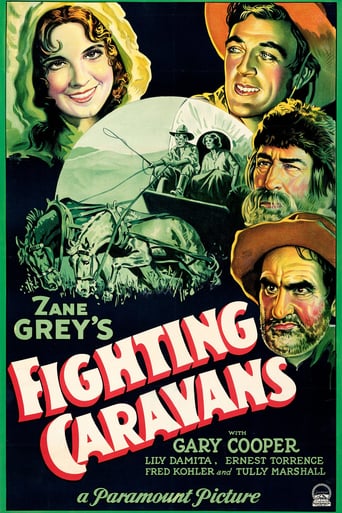

"Fighting Caravans", while an "A" picture in presentation, is a "B" picture in spirit. Even allowing for the fact that talkies had only been around for a few years when this film came out in 1931, it's still very much rooted in silent-era melodrama, even though some comedy scenes between veterans Ernest Torrance and Tully Marshall are injected in an attempt to lighten things up. Gary Cooper is effective, if still a bit hesitant in delivering his lines, and his love interest Lili Damita is pretty and sexy but wildly miscast and not up to the job. The film had two directors, and it's painfully obvious which one did what--David Burton, a Russian émigré brought out from the Broadway stage, directed the non-action scenes and his background shows in the unimaginative staging (this was only his third film as a director) and overexaggerated acting. Co-director Otto Brower was an action specialist and second-unit director, and while he did some excellent work later in his career (he worked on 1946's "Duel in the Sun", 1944's "Buffalo Bill" and 1939's "Jesse James", among dozens of others), the climactic Indian attack in this film is actually pretty ineptly staged; although there are a lot of Indians riding around, whooping and getting shot off their horses, it's not particularly exciting or even involving and, in addition, is very poorly edited.If Paramount meant this picture to be its answer to "The Big Trail", "The Iron Horse" or "The Covered Wagon", it fails badly. It has its moments (there's a good bar brawl about halfway through the picture) and Torrance and Marshall work well together, but all in all, it's just a "B" picture in everything but budget, and not as good as many others that cost far less. Worth a watch once, maybe, but not more than that.
... View MoreIn Missouri, during the Civil War, "high, wide, and handsome" Gary Cooper (as Clint Belmet) gets a little jail cell shut-eye. Awakening, he moseys over to the local saloon, where he is held at gunpoint by the town's drunken sheriff. Mr. Cooper's guardians, Ernest Torrence (as Bill Jackson) and Tully Marshall (as Jim Bridger), secure his release by convincing French lass Lili Damita (as Felice) to pretend she is Cooper's wife. Then, the quartet join a caravan to California. A real romance begins to bloom between Ms. Damita; but, Mr. Torrence and Mr. Tully want Cooper's bachelorhood preserved. Along the way, Indians (Native Americans) lurk Old pros Torrence and Marshall are "Fighting Caravans" main attraction. They were responsible for many memorable character roles (mostly) in silent films (mostly); and they are in excellent form, reprising their "Covered Wagon" roles. Cooper obviously enjoys working with them. Ms. Damita is cute and effective. The production levels are relatively high, leading to the obligatory ending battle; but, the performances make it entertaining. Unnecessarily re-made as "Wagon Wheels" (1934), with stock footage and Randolph Scott. ******* Fighting Caravans (2/1/31) Otto Brower, David Burton ~ Gary Cooper, Ernest Torrence, Tully Marshall
... View MoreThe main flaw to this movie is Gary Cooper. He was a great actor, but in this film appears to be in a not-yet-mature stage in his career. Cooper plays a lanky happy-go-lucky cowboy, who can turn the wrong direction or the right direction at this point in his young life. The heroine is a tough woman, but who still has a woman's heart. She can be very tough, but still expects to be treated right by a man. Instead of seeing what a great wife and partner for life she would be, Cooper's character struggles with many dilemmas before choosing this path. The best characters in the film are two older men, who are scouts. They are a dying breed and the coming of the railroad threatens to destroy their livelihoods. They are very selfish and want to keep their young apprentice (Cooper) under their wings. They try everything to destroy the budding romance between the hero and heroine. In the end, they realize that they have been fools, and decide that supporting the romance is after all the best solution. I liked the fact that the Native Americans were portrayed with some sensitivity. This was 1931. The main bad guy was white. While continuing some of the stereotypes about Native Americans - that they are brutal, the movie was at least light-hearted and comical, rather than pursuing an agenda of hatred towards the Native Americans. The ending was nice. Everybody finds love. Even an older man finds a Native American bride.
... View Morelet's weigh the merits of this film: (1) a strikingly handsome (and tall), youthful Gary Cooper -- this is the opportunity to see a giant screen legend when he was a vibrant young newcomer! This alone merits seeing this movie. (2) The dialogue is witty, pithy and fun -- in fact, give me the screenwriter from 1931 over most of today's movies!. (3) There is a lot of fast-paced and exciting western action (and the stuntwork is just plain fun to watch). Yes, this was relatively early movie making, and in some ways it shows, but that also provides tremendous enjoyment for the film buff. Watch it with a light heart, but with reverence for the old films, and I think you can't help but enjoy it.
... View More